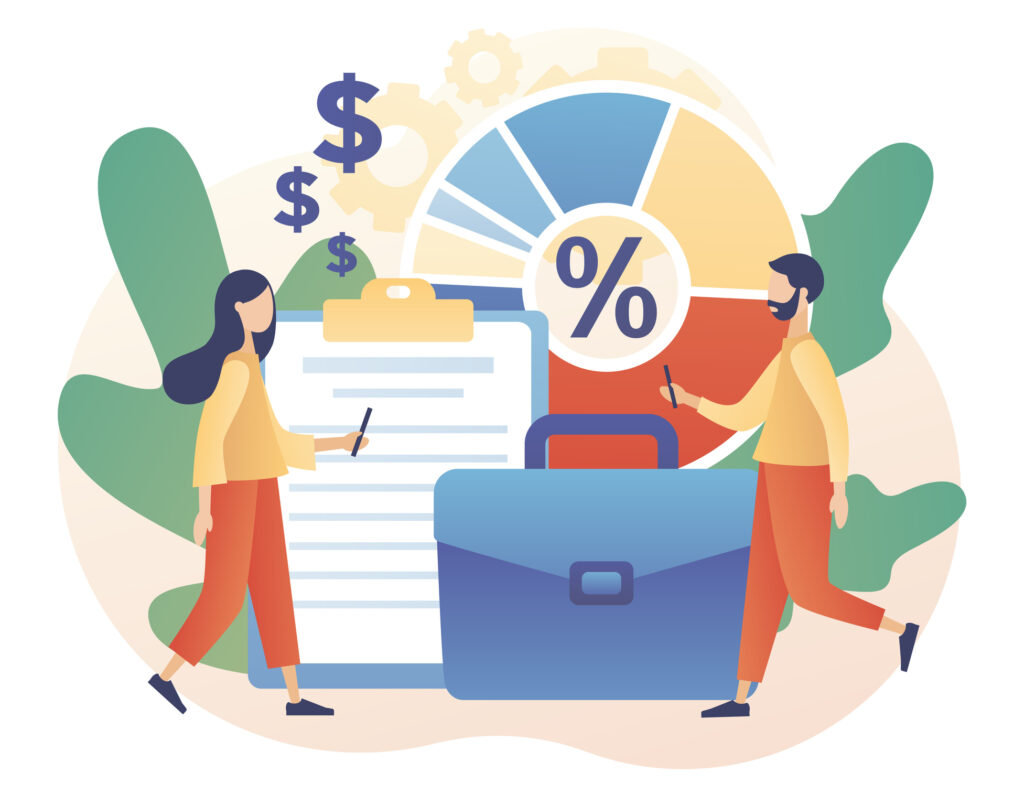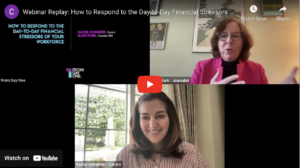This blog was co-written by Canary’s Catherine Scagnelli and Rachel Schneider.
We all experience the unexpected. This week, for one person, it may be a broken dishwasher. For someone else, it may be a car repair, a leaking roof, or a trip to the ER. We simply cannot know in advance about every financial disruption headed our way. There’s always something.
What is less universal, however, is how we weather these ups and downs. For many people, we can respond smoothly by relying on our savings or asking our family for help. But, for the 63% of Americans who live paycheck to paycheck, the unexpected quickly becomes an emergency.
This fact is widely recognized, leading to innovation in the fintech sector. Many of these innovators are solving financial emergencies via the workplace. Canary is part of this wave of innovation, so employers often ask us how other workplace financial health solutions compare and where Canary fits in. Spoiler alert: we recommend a portfolio approach grounded in understanding the available solutions, why companies offer them, and how they help employees deal with financial emergencies. This blog lays the groundwork for ongoing conversation about this complex topic.
A focus on workplace wellness programs: why work is ripe for innovation
First – why employers in the first place? Workplaces have some natural advantages for fintech innovation. Work is where many of us spend the majority of our waking hours. It is the most significant input into the financial lives of everyone except for the very poor and the very wealthy. So, what happens at work around money matters. Plus, employers aggregate large numbers of people in one place, providing a cost-effective entry point into marketing and selling financial products (ie, they lower the cost of customer acquisition). Employers are motivated third-party buyers, capable of and willing to subsidize financial products that help their employees manage financial disruptions. Plus, employers increasingly know that assisting their workforce with financial health is the right thing to do for their people AND their bottom line, given the high cost of financial distress on productivity.

The federal government recognizes this as well. By passing Secure Save 2.0 (which allows retirement plan providers to offer “within plan” emergency savings accounts), Congress has acknowledged that employers and employees are trying to find better ways to manage emergencies and that there should be a path to solving them through employee wellness solutions.
Employer responses to employees’ financial hardship
So, if you’re an employer trying to figure out what to do to help your colleagues better manage financial emergencies, we recommend thinking about your options in four buckets:
- Information & Planning
- What it is: Access to financial information, advice, or personalized coaching to help people make the most of their money.
- Why offer it: Financial decisions are complicated and stressful. People need help navigating the sea of information and applying it to their situation.
- Options available: There is a continuum here, with providers offering purely information at one end and providers offering ongoing, personalized advice through one-on-one relationships between financial advisors and employees at the other.
- Best practices:
- To increase the likelihood of use, allow access to these services on the clock during the work day.
- Managers should model using them and talk about it openly, normalizing asking for financial help. That doesn’t mean the weekly staff meeting needs to become a personal finance sharing circle — but it will help if leaders make it clear that everyone has financial questions.
- How it helps with financial emergencies: When someone is in the middle of a crisis, they aren’t looking for recommendations about long-term savings for retirement. But, it can be a powerful time to establish rapport and share a few steps or resources for immediate relief. This may mean directly connecting an employee to other financial products or an emergency relief program.
- Financial Products
- What it is: Access to financial services such as savings accounts and loans that give people preferred pricing or better-functioning products than they can buy on their own.
- Why offer it: The payroll function is a powerful piece of infrastructure. Using it to help people save or pay off debt directly from their paycheck makes those activities – which are often tough habits to establish – more likely to happen.
- Options available: So far, the primary options are emergency savings, early wage access, and personal loans, though more insurance products are coming into the market.
- Best practices:
- If you offer an emergency savings account, an employer match is the gold standard. It is likely to be appreciated by many employees even more than a 401(k) match.
- If you offer early wage access, limiting the number of times it can be accessed ensures that the individual uses the funds to pay for an emergency versus simply paying a fee to change their payday from Friday to Wednesday.
- Similarly, if you offer personal loans that are repaid out of future pay, limiting the amount people can use and the fees they will pay is essential so they don’t become overindebted.
- How it helps with financial emergencies: Saving is a great way to prevent an unexpected event from becoming a financial emergency, while taking one’s pay early or borrowing is sometimes the best (or only) way to manage an emergency. These methods are most effective if the individual can set aside money regularly. Some individuals can only save intermittently and face unexpected emergencies before saving enough, or the prospect of loan repayment is challenging. In these scenarios, offering access to emergency payments can offer all employees a path to financial recovery
- Emergency Grant Payments
- What it is: Access to an additional charitable payment (with no expectation of repayment) during the crisis.
- Why offer it: Giving someone money is the simplest, most direct way to help a fellow employee recover during a financial crisis.
- Options: Employers can make an emergency payment directly to an employee in need or partner with a third party (in full disclosure, like Canary) to manage the emergency grant program.
- Best practices:
- When offering emergency funds, it is crucial to have a standardized program backed by clear, specific eligibility criteria to ensure quick, equitable, and consistent decisions.
- Ensuring employee privacy and anonymity by working with a third-party provider helps employees feel at ease and empowers individuals who typically wouldn’t approach a manager with sensitive financial issues.
- It is also best to embed the program within an employee engagement strategy, allowing individuals to donate to the emergency fund for their fellow employees and enabling them to access help themselves.
- How it helps with financial emergencies: Offering employees a financial gift that does not have to be paid back makes a significant dent in solving the financial emergency, even if it doesn’t cover the total cost. It also sends a message of caring from the community, becoming a powerful culture builder and expressing the company’s values.
- The Status Quo
- What it is: This is whatever you and your co-workers do today, including taking 401(k) loans and hardship withdrawals, circulating GoFundMes, setting up one-off programs right after a natural disaster, giving extra days off, or enabling the occasional pay advance.
- Best practices:
- Some level of flexibility is important and should be encouraged.
- But, ultimately, it is easier to deliver fair and efficient support for employees in crisis through employee health solutions that are designed for that purpose and can be delivered by providers who specialize in understanding best practices across this growing sector.
- How it helps with financial emergencies: In our many conversations with HR leaders, we find that almost everyone has dealt with employees in crisis by finding creative ways to use their existing resources. This is a great start and helps leaders to understand the problem they are trying to solve.
We recommend a portfolio approach to workplace wellness programs
At Canary, we see the impact of emergency money every day. We see it help employees recover in the face of eviction notices, the loss of a family member, and domestic issues. We obviously encourage all employers to consider emergency cash grants within their employee financial health strategy to solve employees’ most pressing economic concerns. That said, we also firmly believe that the best (and most complete) route for employers is to offer multiple solutions that complement each other. The employers that get the most out of new employee financial wellness solutions will be the ones who deeply understand the realities their workers face, the value and limitations of available solutions, and invest in a set of tools that scaffold workers wherever they are in their financial lives.

Contact our team today to learn more about supporting your employees through financial hardships. In the meantime, download our most recent Impact Report to learn how employee relief funds support modern, diverse workforces in uncertain times.






